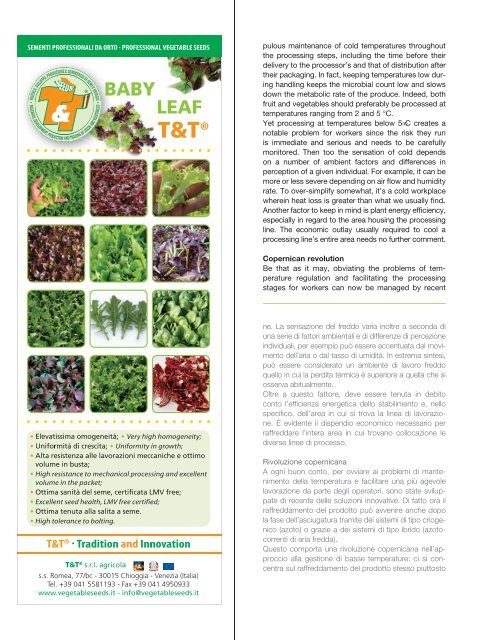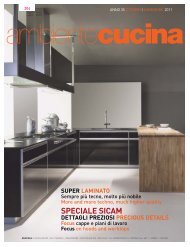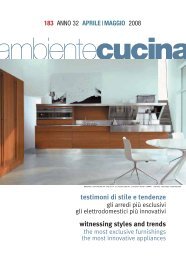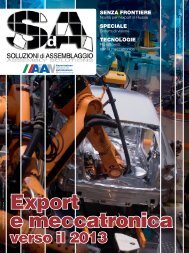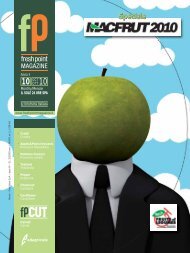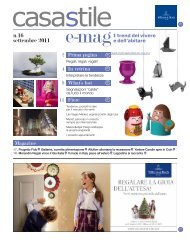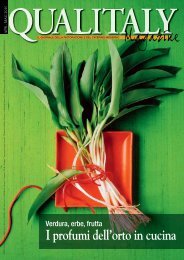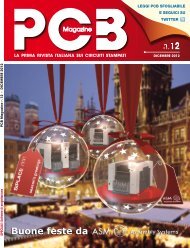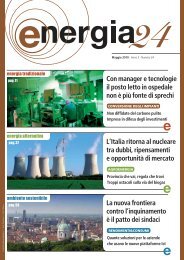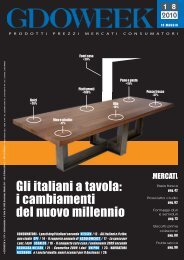Fresh Point Magazine - B2B24 - Il Sole 24 Ore
Fresh Point Magazine - B2B24 - Il Sole 24 Ore
Fresh Point Magazine - B2B24 - Il Sole 24 Ore
You also want an ePaper? Increase the reach of your titles
YUMPU automatically turns print PDFs into web optimized ePapers that Google loves.
pulous maintenance of cold temperatures throughout<br />
the processing steps, including the time before their<br />
delivery to the processor’s and that of distribution after<br />
their packaging. In fact, keeping temperatures low during<br />
handling keeps the microbial count low and slows<br />
down the metabolic rate of the produce. Indeed, both<br />
fruit and vegetables should preferably be processed at<br />
temperatures ranging from 2 and 5 °C.<br />
Yet processing at temperatures below 5C creates a<br />
notable problem for workers since the risk they run<br />
is immediate and serious and needs to be carefully<br />
monitored. Then too the sensation of cold depends<br />
on a number of ambient factors and differences in<br />
perception of a given individual. For example, it can be<br />
more or less severe depending on air fl ow and humidity<br />
rate. To over-simplify somewhat, it’s a cold workplace<br />
wherein heat loss is greater than what we usually fi nd<br />
Another factor to keep in mind is plant energy effi ciency,<br />
especially in regard to the area housing the processing<br />
line. The economic outlay usually required to cool a<br />
processing line’s entire area needs no further comment.<br />
Copernican revolution<br />
Be that as it may, obviating the problems of temperature<br />
regulation and facilitating the processing<br />
stages for workers can now be managed by recent<br />
ne. La sensazione del freddo varia inoltre a seconda di<br />
una serie di fattori ambientali e di differenze di percezione<br />
individuali, per esempio può essere accentuata dal movimento<br />
dell’aria o dal tasso di umidità. In estrema sintesi,<br />
può essere considerato un ambiente di lavoro freddo<br />
quello in cui la perdita termica è superiore a quella che si<br />
osserva abitualmente.<br />
Oltre a questo fattore, deve essere tenuta in debito<br />
conto l’effi cienza energetica dello stabilimento e, nello<br />
specifi co, dell’area in cui si trova la linea di lavorazione.<br />
È evidente il dispendio economico necessario per<br />
raffreddare l’intera area in cui trovano collocazione le<br />
diverse linee di processo.<br />
Rivoluzione copernicana<br />
A ogni buon conto, per ovviare ai problemi di mantenimento<br />
della temperatura e facilitare una più agevole<br />
lavorazione da parte degli operatori, sono state sviluppate<br />
di recente delle soluzioni innovative. Di fatto ora il<br />
raffreddamento del prodotto può avvenire anche dopo<br />
la fase dell’asciugatura tramite dei sistemi di tipo criogenico<br />
(azoto) o grazie a dei sistemi di tipo ibrido (azotocorrenti<br />
di aria fredda).<br />
Questo comporta una rivoluzione copernicana nell’approccio<br />
alla gestione di basse temperature: ci si concentra<br />
sul raffreddamento del prodotto stesso piuttosto


